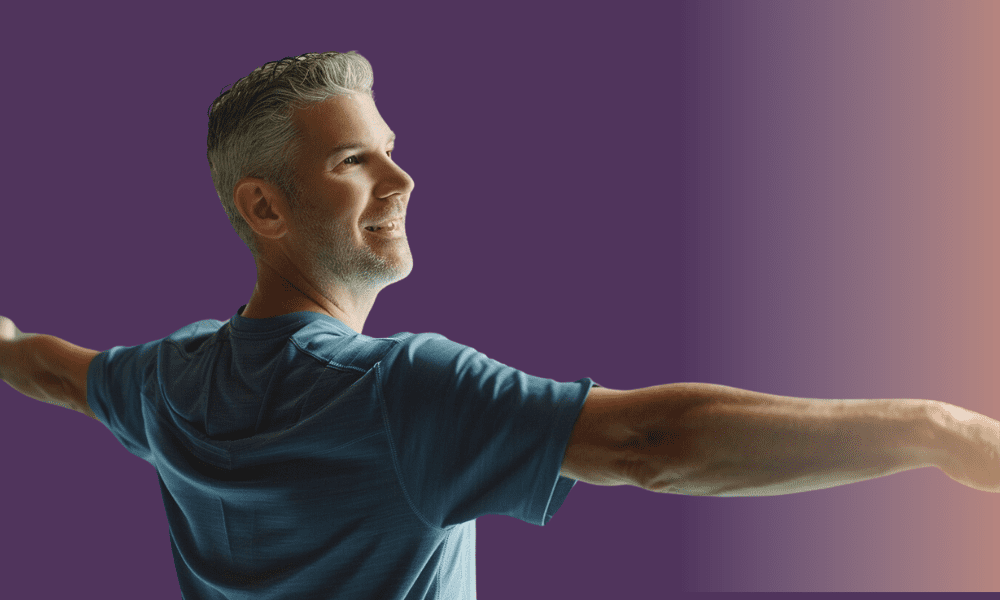Safeguarding Your Spine: Exercises and Stretches For Herniated Disc Pain
Introduction
Bulging discs significantly impact quality of life by affecting daily activities and exercise routines. Dr. Matthias Wiederholz, MD, a board-certified pain management specialist at Performance Pain and Sports Medicine, highlights the importance of properly managing this condition. With his extensive experience in spinal disorders, Dr. Wiederholz plays a crucial role in helping patients navigate spinal health challenges, advocating for practices that enhance well-being without worsening symptoms.
The condition not only causes discomfort but also limits mobility and the performance of daily tasks. Dr. Wiederholz educates patients on choosing exercises that strengthen the back and reduce injury risk, balancing an active lifestyle with spinal health. His expertise in pain management and commitment to patient education offer valuable insights into managing bulging discs effectively, ensuring patients can lead active, healthy lives while prioritizing their spinal health.

Understanding Bulging Discs
Bulging discs represent a significant concern within spinal health, impacting an individual’s ability to engage in daily activities and exercise routines effectively. Conditions such as disc desiccation can exacerbate this impact, as the loss of fluid in discs leads to reduced flexibility and potential for bulging or herniation.
Dr. Matthias Wiederholz, MD, a renowned expert in pain management, underscores the importance of recognizing and appropriately managing this condition to maintain an active and healthy lifestyle. Understanding which exercises to avoid with a herniated disc and whether it is okay to do squats with a bulging disc are crucial aspects of this management.
What are Bulging Discs, and Why Do They Matter?
Bulging discs occur when the disc material between the vertebrae protrudes beyond its normal perimeter, potentially leading to nerve irritation and pain. This condition is significant because it can severely limit mobility and cause chronic discomfort, affecting an individual’s quality of life. Knowledge about bulging discs is essential for anyone looking to prevent or manage spinal health issues.

Common Symptoms and Causes
The symptoms of bulging discs can vary but often include pain, numbness, and a tingling sensation that can radiate from the back to other parts of the body. Causes range from natural aging and degeneration of the spine to physical strain from improper lifting or sudden injury. For those experiencing lower back issues, being familiar with L5-S1 pain and its causes can provide crucial insights for early detection and management. Recognizing these symptoms and understanding the causes is the first step toward effective management.
The Mechanism of Injury
The mechanism of injury in bulging discs often involves actions that place undue stress on the spine, such as heavy lifting, prolonged sitting, or engaging in exercises that strain the back. When considering exercises to avoid with a herniated disc, it’s important to exclude activities that exacerbate these stresses, potentially worsening the condition.
Identifying Risk Factors
Several risk factors can predispose individuals to bulging discs, including genetics, lifestyle choices, and occupational hazards. A sedentary lifestyle, for example, can weaken the muscles supporting the spine, increasing the risk of disc issues. In terms of exercise, caution is advised; while asking, “Is it ok to do squats with a bulging disc?” one must consider the form, weight, and frequency of such exercises. Squats can be beneficial when performed correctly but may pose a risk if done improperly or without professional guidance.
In conclusion, understanding bulging discs—their causes, symptoms, and the mechanism of injury—is vital for effective prevention and management. Identifying and mitigating risk factors, along with making informed decisions about exercise routines, particularly regarding exercises to avoid with a herniated disc, are key components of maintaining spinal health. Dr. Wiederholz’s expertise in pain management provides a valuable resource for individuals navigating these challenges, ensuring that they can lead active, fulfilling lives without compromising their spinal well-being.

Safe Exercise Alternatives for Bulging Discs
For individuals navigating the challenges of bulging discs, selecting safe and effective exercises is crucial to managing symptoms and improving spinal health. Dr. Wiederholz emphasizes the importance of incorporating exercises that strengthen the back without placing additional stress on vulnerable areas. Through a carefully curated regimen, it’s possible to enhance core stability, maintain cardiovascular health, and increase flexibility, all while safeguarding the spine.
Core Strengthening Exercises
Strengthening the core is fundamental for individuals with bulging discs, as a strong core supports the spine, reducing the load on the discs. Dr. Wiederholz recommends exercises that focus on stabilizing the core without excessive twisting or bending.
- Planks: Begin in a prone position, resting on your forearms and toes. Keep your body in a straight line from head to heels, engaging your core to support your spine. Hold this position for 20 to 30 seconds, gradually increasing the duration as your strength improves.
- Bird-Dog: Start on your hands and knees, ensuring your hands are directly under your shoulders and your knees under your hips. Extend one arm forward and the opposite leg back, keeping both parallel to the floor. Hold for a few seconds, then switch sides. This exercise enhances core stability and spinal alignment.
Low-Impact Aerobic Activities
Maintaining cardiovascular fitness is essential for overall health, but high-impact activities can be detrimental for those with bulging discs. Dr. Wiederholz suggests low-impact aerobic exercises that provide cardiovascular benefits without stressing the spine.
- Walking: A brisk walk, especially on even terrain, can significantly improve cardiovascular health without jarring the spine.
- Swimming: Water provides natural resistance and supports the body, making swimming an excellent way to strengthen muscles without impact.
- Cycling: Stationary or recumbent cycling can be a great way to get a cardiovascular workout with minimal spinal stress.
Stretching for Flexibility and Relief
Flexibility exercises are key to managing bulging disc symptoms, offering relief and preventing further injury. Dr. Wiederholz highlights the importance of gentle stretching routines that focus on the back and surrounding areas.
- Cat-Cow Stretch: On your hands and knees, alternate between arching your back towards the ceiling (cat) and dipping it towards the floor (cow). This movement enhances spinal flexibility and relieves tension.
- Hamstring Stretch: Sitting on the floor with your legs extended, gently reach forward towards your toes, keeping your back straight. This stretch alleviates tension in the back by loosening the hamstrings.
Under the expert guidance of a qualified physician, adopting these safe exercise alternatives can lead to significant improvements in managing bulging discs. By focusing on core strengthening, low-impact aerobic activities, and flexibility exercises, individuals can maintain an active lifestyle while prioritizing their spinal health, ensuring a balanced approach to wellness and pain management.

Building a Bulging Disc-Friendly Workout Routine
Creating a workout routine that accommodates bulging disc conditions is essential for anyone looking to maintain an active lifestyle while managing spinal health. Dr. Matthias Wiederholz, MD, a leading pain management expert at Performance Pain and Sports Medicine, offers invaluable advice on constructing a balanced exercise plan that supports the spine and mitigates the risk of exacerbating bulging disc symptoms. The key lies in embracing consistency and moderation, ensuring that each workout contributes positively to spinal health.
Tips on Creating a Balanced Exercise Plan
- Start with a Warm-Up: Begin every workout session with a gentle warm-up to prepare your body for exercise. This can include light walking or cycling for 5-10 minutes, followed by dynamic stretches. Warming up increases blood flow to the muscles and can reduce the risk of injury.
- Incorporate a Variety of Exercises: A well-rounded routine includes core strengthening, low-impact aerobic activities, and flexibility exercises. Dr. Wiederholz emphasizes the importance of diversifying your workouts to prevent overuse injuries and ensure that all aspects of physical fitness are addressed.
- Focus on Form and Technique: Proper form is crucial to preventing additional strain on the spine. Whether you’re performing core exercises or engaging in low-impact aerobics, maintaining correct posture and alignment protects your back. Seek guidance from professionals like Dr. Wiederholz to ensure your technique is correct.
- Listen to Your Body: Recognize the difference between normal muscle fatigue and pain. If an exercise causes discomfort or exacerbates your symptoms, stop immediately. Adjusting your routine based on your body’s responses is crucial for managing a bulging disc.
The Role of Consistency and Moderation
Consistency in your workout routine is vital for long-term management of bulging disc symptoms. Regular, moderate exercise helps strengthen the muscles supporting the spine, reducing the likelihood of future flare-ups. However, moderation is equally important. Dr. Wiederholz advises against overexerting yourself, as doing too much too soon can lead to setbacks in your recovery. Balancing activity with adequate rest allows the body to heal and adapt, minimizing the risk of aggravating the condition.
By focusing on consistency, moderation, and a balanced approach to exercise, individuals with bulging discs can manage their symptoms effectively, ensuring a healthier, more active lifestyle without compromising their spinal health.
When to Seek Professional Advice
Embarking on a journey to manage bulging disc symptoms through exercise is commendable, yet it’s crucial to recognize when professional advice is necessary. Dr. Matthias Wiederholz, and Dr. Manzi, leading experts at Performance Pain and Sports Medicine, stress the importance of consulting healthcare professionals before introducing new exercises into your routine.
This precaution ensures that your chosen activities support your spinal health without risking further injury. For those seeking advanced solutions beyond physical therapy, our practice offers a range of minimally invasive pain management procedures tailored to provide relief and improve quality of life.
Minimally Invasive Procedures
At Performance Pain and Sports Medicine, we specialize in cutting-edge treatments designed to address the root cause of spinal discomfort with minimal recovery time. Among these, The Discseel® Procedure, Epidural Steroid Injections, and the Intrathecal Pain Pump stand out as effective solutions for managing chronic pain associated with bulging discs.
The Discseel® Procedure, in particular, represents a revolutionary approach to spinal healing. Dr. Wiederholz, a board-certified pain management specialist, has the distinction of being the first doctor in Houston to be personally trained by Dr. Pauza in the Discseel® Procedure. This innovative treatment involves the injection of a biologic material to seal and heal damaged spinal discs, offering a promising alternative to more invasive surgeries. Dr. Wiederholz’s expertise in this procedure is available to patients in both Houston and Lawrenceville, New Jersey, marking our clinic as a pioneer in providing this advanced treatment in the region.
Epidural Steroid Injections and Intrathecal Pain Pumps are also part of our comprehensive approach to pain management, offering targeted relief for spinal conditions. The Intrathecal Pain Pump, delivers pain medication directly to the spinal cord, providing continuous pain relief with reduced side effects compared to oral medications.
Consultation Availability
Understanding the unique challenges of each patient’s condition, Dr. Wiederholz and Dr. Manzi are available for consultations across our locations in Houston and League City in Texas, as well as Lawrenceville in New Jersey. Our team is committed to providing personalized care, from initial consultation to post-procedure support, ensuring that each patient receives the most effective treatment plan for their needs.
In conclusion, while exercise plays a crucial role in managing bulging disc symptoms, the expertise of healthcare professionals like Dr. Wiederholz and Dr. Manzi is invaluable in navigating the path to recovery. Through a combination of personalized exercise recommendations and advanced minimally invasive procedures, Performance Pain and Sports Medicine offers a holistic approach to spinal health, empowering patients to achieve lasting relief and improved well-being. Moreover, an understanding of the best painkiller for herniated disc can be an essential aspect of your pain management strategy.
Conclusion
Navigating the complexities of living with bulging discs requires a balanced approach, combining exercise, awareness, and professional medical advice. Dr. Matthias Wiederholz, MD, and Dr. Manzi of Performance Pain and Sports Medicine have underscored the importance of selecting appropriate exercises to strengthen the back safely, avoiding activities that may exacerbate the condition, and embracing minimally invasive procedures for those seeking advanced treatment options.
The introduction of revolutionary treatments like The Discseel® Procedure, alongside Epidural Steroid Injections, and the Intrathecal Pain Pump, represents a significant leap forward in pain management and spinal health.
As we conclude, remember the importance of listening to your body and recognizing the signs it sends. Prioritizing your spinal health is not just about managing symptoms but about enhancing your overall quality of life. Whether through carefully chosen exercises, lifestyle adjustments, or considering advanced medical treatments, the goal is to live a life defined not by limitations but by possibilities.
For those exploring their options or seeking to understand more about how they can manage bulging disc symptoms effectively, Performance Pain and Sports Medicine is here to guide you. Our team, led by pioneers like Dr. Wiederholz, offers personalized consultations to determine the most appropriate course of action for your specific condition. Whether you’re a candidate for one of our groundbreaking procedures or looking for guidance on managing your condition, we invite you to reach out.
Additionally, our online store provides access to prescription pain patches and peptides for weight loss, muscle gain, and more, supporting your journey towards optimal health and wellness. These carefully selected products complement our holistic approach to pain management and rehabilitation.
To learn more about how you can benefit from our expertise or to find out if you are a candidate for one of our procedures, contact us today. Let us be your partners in prioritizing your spinal health and navigating your fitness journey with confidence and care.

















